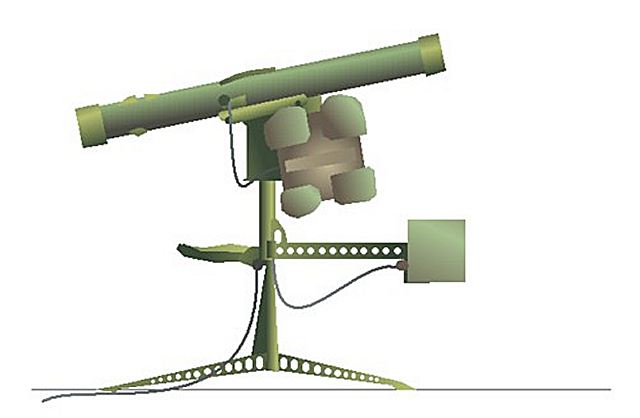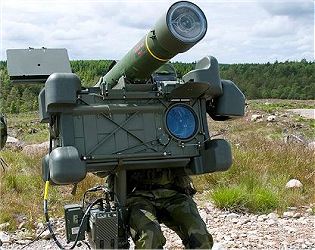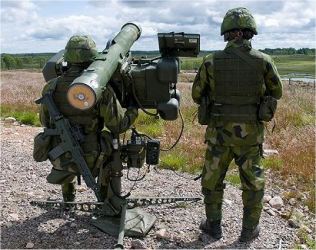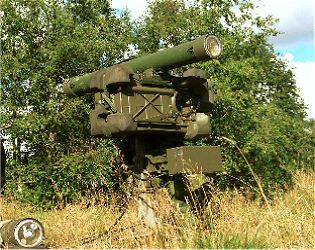- Army
- Air Defense Systems
- Anti-tank systems and vehicles
- Armored Vehicles
- Armoured personnel carriers
- Artillery Vehicles and Weapons
- Command Post
- Communication Vehicles and Systems
- Electronic Warfare
- Engineer | Maintenance Vehicles
- Infantry Fighting Vehicles
- Main Battle Tanks
- Missiles
- Tactical and Logistic Vehicles
- Radars
- Unmanned Systems
- Weapons
- Navy
- Air
RBS 70
RBS 70 MANPADS
Man Portable Air Defense Missile System - Sweden

Description
The RBS 70 is a man-portable air-defense missile system (MANPADS) designed for air defense warfare in all climate zones and with little to no support from other forces. The RBS 70 is designed and manufactured by the Swedish defense Company SAAB. The RBS 70 was developed to supply the Swedish air defense with a low-cost, easy-to-use, and effective short-range SAM system. The first delivery of RBS 70 missile systems for trial purposes was made in late 1973 with user trials conducted between 1974 and 1975. In a three-phase evaluation program, the Swedish Army fired more than 100 complete test rounds fitted with telemetry heads. In 1975, the program was completed satisfactorily and, in June of that year, the first production orders were placed for the Rb70 missiles, sights, stands, and PI-69 IFF sets. It entered service in 1977 as the first laser-guided defense missile system in the world and now it is used by 18 countries over the world in all climate zones as Australia, Argentina, Brazil, United Arab Emirates, Iran, Ireland, Norway, Pakistan, Sweden, Czech Republic, and others. On 17 November 2022, the Swedish government decided to donate RBS 70 MANPADS, including ammunition to Ukraine. A week later, the training started in Sweden.
RBS-70 MANPADS variants:
- RBS 70 NG: the system is equipped with a new NG (New Generation) sight. The RBS 70 NG sight enhances the capability of the BOLIDE missile by reducing the tracking noise through the implementation of an auto-tracker function.
Technical Data
| Design |
|
The basic fire unit comprises a tripod stand and the sight as the two major parts. Each constitutes a one-person pack with a third team member carrying missiles in container-launcher tubes. Three men are required to transport it, while just one man is required to operate it. The IFF equipment, if used, forms another portable pack as does the target data receiver terminal, which is used in conjunction with the Giraffe search radars.
|
 |
| Missiles |
|
The basic 15-kg Missile Mk 0 (Robot70, Rb70) is a two-stage, solid propellant, rocket-motor powered type. It is never removed from its container-launcher tube when in the field but, once fired, the tube is discarded. Both impact and active laser proximity fuses are fitted to the HE-shaped charge pre-fragmented warhead that is surrounded by some 2,000 to 3,000 tungsten pellets each with an optimized diameter of 3 mm.
The Missile Mk 2 (Rb90) is different internally but remains the same in overall size and weight. The electronics have been considerably miniaturized to fit a larger sustainer and new combined warhead with over 3,000 tungsten pellets and two shaped charges. The new sustainer increases both the missile velocity profile and the maximum range and altitude (up to 7,000 m as opposed to 6,000 m of the other round types against slow-moving targets and from 3,000 to 4,000 m altitude). The latest generation of the missile for the RBS 70 launcher unit is the Bolide which is a development of the RBS 70 Mk2. The Bolide missile design incorporates a number of new systems including a fiber-optic gyroscope, an adaptable proximity fuse that provides all-target capability and a high kill probability against small and dark targets, a new sustainer rocket motor with an improved performance propellant and new electronics. The new sustainer rocket motor gives the missile a shorter time of flight and higher maneuverability than the RBS 70. It has a maximum speed of more than Mach 2, faster than the RBS 70 which has a speed of Mach 1.6. |
| Operations |
| For an engagement, the tubular stand assembly is removed from its carrying harness and the three legs unfolded and roughly leveled by adjustments to one of them. The operator's seat is then unfolded from the vertical central tube and the gyrostabilizer sight, battery power supply, IFF unit, and container-launcher missile tube are attached. All the electrical connections are made to these units, the operator's headset and the data receiver terminal if present. A well-trained crew will take only 30 seconds to complete all these procedures. The RBS 70 can be also mounted on a wheeled or tracked combat vehicle. In vehicle applications, the RBS 70 VLM (Vehicle Launched Missile) can easily be dismounted and used independently. In a complete air defense system configuration, up to 9 RBS-70 firing tripods can be connected to surveillance radar like Ericsson’s Giraffe 75, enabling all C3I functions. |
| Combat Use |
| With the BOLIDE missile, the RBS 70 NG aims at the complete threat spectrum from fixed and rotary-wing aircraft down to small targets such as cruise missiles and UAVs, out to a range of 8 kilometers and with altitude coverage in excess of 5,000 meters. A hostile target can be located visually by the missile operator or the target can be detected by search radar. When the target is acquired, the operator tracks the target and the Raytheon Cossor IFF880 friend or foe system interrogates the target. If a friendly target is detected, a warning light in sight is illuminated and the firing sequence is halted. The operator aims the missile towards the target, fires and tracks the target, aiming a laser guidance beam continuously at the target until the moment of impact. Several fire units can be connected to surveillance radar to form an anti-aircraft battery. If the RBS 70 is not interfaced with surveillance radar, it can operate autonomously. |
Specifications
| Armament | Type of targets |
| One Mk1 or Mk2 or Bolide missile. | Tactical aircraft, helicopters, UAVs, and cruise missiles |
| Country users | Missile |
| Argentine, Australia, Bahrain, Brazil, Czech Republic, Finland, Indonesia, Ireland, Latvia, Lithuania, Mexico, Pakistan, Singapore, Sweden, Thailand, Tunisia, United Arab Emirates, Venezuela, Ukraine | Weight: 16.5 kg (at launch) Weight Warhead: 1 kg Warhead type: HE-shaped charge Fragmentation Flight speed: 580 m/s Altitude: 0 - 4,000 m |
| Designer Country | Reaction Time |
| Sweden | Less than 6 sec |
| Combat Weight | Range |
| 35 kg ready to fire | 200 to 8,000 m |
| Crew | Dimensions |
| 3 | Length: 1.318 m; Diameter: 106 mm; Wingspan: 32 cm |
Details View
 |
|
 |
 |
 |
 |
Pictures - Video



























